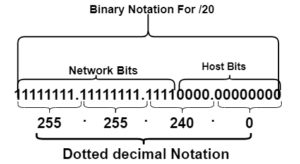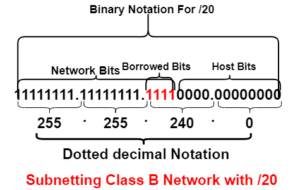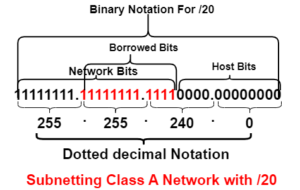The /20 subnet mask is the subnet mask with dotted decimal notation of 255.255.240.0 and the wildcard mask of 0.0.15.255.
/20 subnet mask divides larger networks like class A and class B networks into smaller networks (subnetworks). Each of these subnetworks has a range of 4096 IP addresses. The first IP address in this range is the network ID, and the last IP address is the broadcast IP address. Hence, there are 4094 usable IP addresses in a /20 subnet mask.
A /20 subnet mask can be subnetted further with a /21 subnet mask, a /22 subnet mask, a /23 subnet mask, and other higher prefix lengths that we discussed earlier.
Subnetting Example with /20 Subnet Mask
When subnetting a network with a /20 subnet mask, you have a total of 4096 IP addresses in each subnet. Here’s an example of how you can subnet the network 192.168.0.0/16 (a class B network) with a /20 subnet mask:
Network Address for the First Subnet: 192.168.0.0
Usable IP Range for the First Subnet: 192.168.0.1 to 192.168.15.254
Broadcast IP Address for the First Subnet: 192.168.15.255
Network Address for the Second Subnet: 192.168.16.0
Usable IP Range for the Second Subnet: 192.168.16.1 to 192.168.31.254
Broadcast IP Address for the Second Subnet: 192.168.31.255
Here is a table of a network subnetted with /20 subnet mask;
| Subnet | Network Address | Usable IP Range | Broadcast Address |
|---|---|---|---|
| 1 | 192.168.0.0 | 192.168.0.1 to 192.168.15.254 | 192.168.15.255 |
| 2 | 192.168.16.0 | 192.168.16.1 to 192.168.31.254 | 192.168.31.255 |
| 3 | 192.168.32.0 | 192.168.32.1 to 192.168.47.254 | 192.168.47.255 |
| 4 | 192.168.48.0 | 192.168.48.1 to 192.168.63.254 | 192.168.63.255 |
| 5 | 192.168.64.0 | 192.168.64.1 to 192.168.79.254 | 192.168.79.255 |
| 6 | 192.168.80.0 | 192.168.80.1 to 192.168.95.254 | 192.168.95.255 |
| 7 | 192.168.96.0 | 192.168.96.1 to 192.168.111.254 | 192.168.111.255 |
| 8 | 192.168.112.0 | 192.168.112.1 to 192.168.127.254 | 192.168.127.255 |
| 9 | 192.168.128.0 | 192.168.128.1 to 192.168.143.254 | 192.168.143.255 |
| 10 | 192.168.144.0 | 192.168.144.1 to 192.168.159.254 | 192.168.159.255 |
| 11 | 192.168.160.0 | 192.168.160.1 to 192.168.175.254 | 192.168.175.255 |
| 12 | 192.168.176.0 | 192.168.176.1 to 192.168.191.254 | 192.168.191.255 |
| 13 | 192.168.192.0 | 192.168.192.1 to 192.168.207.254 | 192.168.207.255 |
| 14 | 192.168.208.0 | 192.168.208.1 to 192.168.223.254 | 192.168.223.255 |
| 15 | 192.168.224.0 | 192.168.224.1 to 192.168.239.254 | 192.168.239.255 |
| 16 | 192.168.240.0 | 192.168.240.1 to 192.168.255.254 | 192.168.255.255 |
/20 Subnet Mask Usable IP Address:
For a /20 subnet mask, there is a range of 4096 IP addresses. The first IP address in this range is the network ID, and the last IP address is the broadcast IP address. Therefore, there are 4094 usable IP addresses in a /20 subnet mask.
/20 Subnet Mask Dotted Decimal Notation
The dotted decimal notation for the /20 subnet mask is 255.255.240.0. This is gotten by setting the first 20 bits of the 32-bit IPv4 address to ‘1s’, setting the remaining 12 bits to ‘0s’, and then converting from binary to decimal.

Subnetting Class B Network with /20 Subnet Mask
To subnet a class B network with a /20 subnet mask, we need to borrow 4 bits from the host bits to obtain the binary representation of a /20 subnet mask, which is 11111111.11111111.11110000.00000000. This is derived from the binary representation of the subnet mask for class B networks, which is 11111111.11111111.00000000.00000000.

The formula for calculating the number of subnets is 2^(number of borrowed bits).
Hence, it would be 2^4 = 16 subnets.
Remember, two subnets are reserved for specific functions according to RFC guidelines. Therefore, the usable number of subnets will be 16 minus 2 = 14.
Subnetting Class A Network with /20 Subnet Mask
To subnet a class A network with a /20 subnet mask, we need to borrow 12 bits from the host bits to obtain the binary representation of a /20 subnet mask, which is 11111111.11111111.11110000.00000000. This is derived from the binary representation of the subnet mask for class A networks, which is 11111111.00000000.00000000.00000000.

The formula for calculating the number of subnets is 2^(number of borrowed bits).
In this case, it would be 2^12 = 4096 subnets.
Remember, two subnets are reserved for specific functions according to RFC guidelines. Therefore, the usable number of subnets will be 4096 minus 2 = 4094.

I am a passionate Networking Associate specializing in Telecommunications.
With a degree in Electronic engineering, I possess a strong understanding of electronic systems and the intricacies of telecommunications networks. I gained practical experience and valuable insights working for a prominent telecommunications company.
Additionally, I hold certifications in networking, which have solidified my expertise in network architecture, protocols, and optimization.
Through my writing skills, I aim to provide accurate and valuable knowledge in the networking field.
Connect with me on social media using the links below for more insights.
You can contact me using [email protected] or connect with me using any of the social media account linked below



